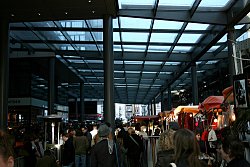Popular on LondonNet
 London Fashion High street trends and funky street styles… |
 Racks to Riches The truth behind vintage shopping in London… |
 Shop Like a Pro Refresh your shopping sense before spending… |
 Shopping Areas The best posh shops and bargain shops… |
The Lovely Dichotomy of Retail
– Spitalfields’ ramshackle stalls, art-deco furniture and catchy energy give Chelsea girls and American tourists a proper place to mingle.
 The hand stitched-bags and charming mosaic patio tables recall the livelier days of Camden market: more uniquely crafted fare and fewer florescent, glow-in-the-dark key chains.
The hand stitched-bags and charming mosaic patio tables recall the livelier days of Camden market: more uniquely crafted fare and fewer florescent, glow-in-the-dark key chains.
The people of Spitalfields Market take pride in this. Many of them have changed professions and chased dreams to open up some of London’s quirkiest shops, spending most of their days holed up in the old fruit and vegetable market that was originally founded by King Charles II, in 1682. They don’t mind all that much, however, because customers are faithful and heed their expert advice – whether it be on leather couches, Kashmir tapestry, or a damn good dress – and Spitalfields seems more a warm little pool of inspiration than a platform for commercial competition, anyway.
A recent marketing campaign comes as the market is set to undergo minor structural development, and the Spitalfields Marketing Group, a board made up of retailers and restaurateurs, hopes to raise its profile amongst the rubble of nearby building work. SMG Chair Maria Hearty, director of Kashmiri textile shop Zaida, said Spitalfields is one of London’s hidden gems.
"It is an alternative to the high street," she said, "It’s independently owned, no chains, with usually original pieces, most fair trade."
Spitalfields is mainly known for its daily markets, where aspiring artists and designers hawk makeshift stalls full of their crafts. Many of the market’s permanent shops began as stalls, including Donna Clarke and Stephen Pavlov’s Little Book of Furniture, which started as a catalogue, then became a stall with a few leather chairs, and eventually grew up to take over a shop where it has since drawn celebrity notoriety for its hand-stitched, Holland-made furnishings.
The story for most of the retailers is similar: good products, loyal customers, and word of mouth have kept their shops and Spitalfields afloat despite massive reconstruction and development in neighbouring blocks. While many of the city’s Georgian and Victorian remnants are being bulldozed for office building spaces and Starbucks, the market prides itself on being anti high-street, with leases excluding all chains and large-name retailers.
MEP Jean Lambert remembers Spitalfields’ carrying organic products long before they were mainstream.
"We don’t want to look like any other place in the rest of the world," she said, "It’s a rooted community, and wants to stay that way."
Most of the restaurants that rim the inner and outer edges of the market still carry organic products, coupled with distinctive cuisine, including the Louisiana-style barbeque Arkansas Cafe, and the lunch-crowd favourite Café Mediterraneo, which mingles in Syrian, Tunisian, Lebanese, Italian and Spanish cuisine.
What Spitalfields is doing that Camden and Covent Garden are not, is holding on to its grassroots with a white-knuckled-death-grip, and the result is a flourishing arts community with the twinkle of growing crowds and frequent celebrity clientele. It is a place where tourists can buy hand-made postcards and Chelsea girls can fine-tune their belt collection, and if it continues to clutch that dichotomy, it will hold solid ground for another 300 years.
– Megan M. Retka
Photo Credit: gahdjun. C.C.License







